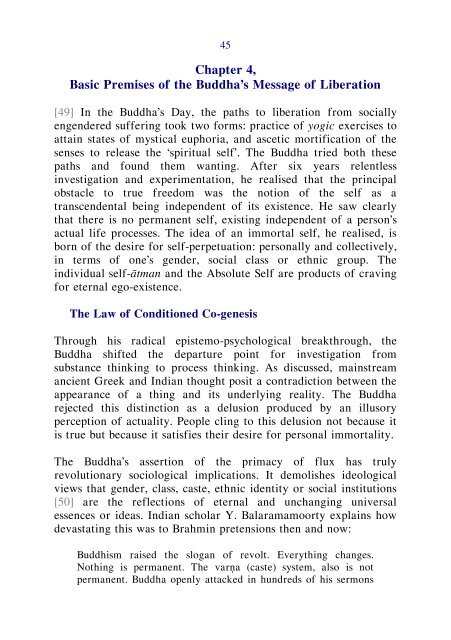Nalin Swaris: Buddhism, Human Rights and Social Renewal
Chapter 1, Foundations of the Western Philosophy of Right Chapter 2, Brahmin Political Theory Chapter 3, The Buddha and His Times Chapter 4, Basic Premises of the Buddha’s Message of Liberation Chapter 5, The Buddha’s Declaration of Human Biological Unity Chapter 6, The Buddha’s Theory of Right Chapter 7, The Buddha’s Theory of Statecraft Chapter 8, The Buddha’s Economic Philosophy Chapter 9, An Alternative Model for Society: the Buddha Sangha Chapter 10, Early Buddhism and Later Centuries Asoka’s Edicts: The First Bill of Human and Animal Rights
Chapter 1, Foundations of the Western Philosophy of Right
Chapter 2, Brahmin Political Theory
Chapter 3, The Buddha and His Times
Chapter 4, Basic Premises of the Buddha’s Message of Liberation
Chapter 5, The Buddha’s Declaration of Human Biological Unity
Chapter 6, The Buddha’s Theory of Right
Chapter 7, The Buddha’s Theory of Statecraft
Chapter 8, The Buddha’s Economic Philosophy
Chapter 9, An Alternative Model for Society: the Buddha Sangha
Chapter 10, Early Buddhism and Later Centuries
Asoka’s Edicts: The First Bill of Human and Animal Rights
Create successful ePaper yourself
Turn your PDF publications into a flip-book with our unique Google optimized e-Paper software.
45<br />
Chapter 4,<br />
Basic Premises of the Buddha’s Message of Liberation<br />
[49] In the Buddha’s Day, the paths to liberation from socially<br />
engendered suffering took two forms: practice of yogic exercises to<br />
attain states of mystical euphoria, <strong>and</strong> ascetic mortification of the<br />
senses to release the ‘spiritual self’. The Buddha tried both these<br />
paths <strong>and</strong> found them wanting. After six years relentless<br />
investigation <strong>and</strong> experimentation, he realised that the principal<br />
obstacle to true freedom was the notion of the self as a<br />
transcendental being independent of its existence. He saw clearly<br />
that there is no permanent self, existing independent of a person’s<br />
actual life processes. The idea of an immortal self, he realised, is<br />
born of the desire for self-perpetuation: personally <strong>and</strong> collectively,<br />
in terms of one’s gender, social class or ethnic group. The<br />
individual self-ātman <strong>and</strong> the Absolute Self are products of craving<br />
for eternal ego-existence.<br />
The Law of Conditioned Co-genesis<br />
Through his radical epistemo-psychological breakthrough, the<br />
Buddha shifted the departure point for investigation from<br />
substance thinking to process thinking. As discussed, mainstream<br />
ancient Greek <strong>and</strong> Indian thought posit a contradiction between the<br />
appearance of a thing <strong>and</strong> its underlying reality. The Buddha<br />
rejected this distinction as a delusion produced by an illusory<br />
perception of actuality. People cling to this delusion not because it<br />
is true but because it satisfies their desire for personal immortality.<br />
The Buddha’s assertion of the primacy of flux has truly<br />
revolutionary sociological implications. It demolishes ideological<br />
views that gender, class, caste, ethnic identity or social institutions<br />
[50] are the reflections of eternal <strong>and</strong> unchanging universal<br />
essences or ideas. Indian scholar Y. Balaramamoorty explains how<br />
devastating this was to Brahmin pretensions then <strong>and</strong> now:<br />
<strong>Buddhism</strong> raised the slogan of revolt. Everything changes.<br />
Nothing is permanent. The varṇa (caste) system, also is not<br />
permanent. Buddha openly attacked in hundreds of his sermons
















